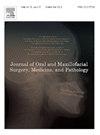高磷酸盐浓度对三维细胞培养系统成骨细胞分化的影响
IF 0.4
Q4 DENTISTRY, ORAL SURGERY & MEDICINE
Journal of Oral and Maxillofacial Surgery Medicine and Pathology
Pub Date : 2024-12-04
DOI:10.1016/j.ajoms.2024.12.003
引用次数: 0
摘要
目的探讨磷酸盐浓度对小鼠成骨前细胞系MC3T3-E1成骨细胞分化的影响。方法构建三维胶原凝胶培养体系,研究磷酸盐浓度对细胞行为的影响。采用三维培养系统观察形态学变化,检测成骨标志物Runx2、Dmp1的表达。结果高浓度(50 mM)的无机磷酸盐(Pi)与对照浓度(10 mM)相比,降低了细胞基质的生成和增殖。免疫组化分析显示,高磷酸盐浓度下Runx2表达较对照浓度升高,2周后高磷酸盐浓度下Runx2表达较对照浓度降低。与对照浓度相比,在高磷酸盐浓度下,Dmp1的表达在整个实验期间从1周开始增加。结论磷酸盐浓度在三维培养成骨细胞分化中起着重要的调节作用。高磷酸盐浓度似乎在初始阶段加速Runx2的表达,随后抑制其表达,同时维持持续的Dmp1表达。我们的研究结果表明,在3D细胞培养中,磷酸盐对成骨细胞分化的影响可能有助于阐明与骨骼发育和骨病发病相关的骨形成和矿化机制。本文章由计算机程序翻译,如有差异,请以英文原文为准。
The impact of high phosphate concentration on osteoblastic differentiation using 3D cell culture system
Objective
This study aimed to investigate the effects of phosphate concentration on osteoblastic differentiation in the murine preosteoblastic cell line MC3T3-E1 within 3D collagen gel culture system.
Methods
To examine the impact of phosphate concentrations on cellular behavior, we constructed the 3D collagen gel culture system. The 3D culture system was used to observe morphological changes and to detect the expression of osteogenic markers (Runx2 and Dmp1).
Results
High (50 mM) concentrations of inorganic phosphate (Pi), a phosphate donor, reduce the cellular matrix production and proliferation compared with the control concentration (10 mM) during the experimental period. Immunohistochemical analysis revealed that Runx2 expression at high phosphate concentration was increased compared with the control concentration, while after 2 weeks, Runx2 expression at high phosphate concentration was decreased compared with the control concentration. Dmp1 expression was increased in high phosphate concentration from 1 week throughout the experimental period compared with the control concentration.
Conclusions
Our findings suggest that phosphate concentration plays a crucial role in modulating osteoblastic differentiation in 3D cell culture. A High phosphate concentration appears to accelerate Runx2 expression at initial stage, and subsequently suppress it, while maintaining sustained Dmp1 expression. Our results suggests that the influence of phosphate on osteoblastic differentiation within 3D cell culture may contribute to elucidation of the mechanisms underlying bone formation and mineralization related to skeletal development and bone disease pathogenesis.
求助全文
通过发布文献求助,成功后即可免费获取论文全文。
去求助
来源期刊

Journal of Oral and Maxillofacial Surgery Medicine and Pathology
DENTISTRY, ORAL SURGERY & MEDICINE-
CiteScore
0.80
自引率
0.00%
发文量
129
审稿时长
83 days
 求助内容:
求助内容: 应助结果提醒方式:
应助结果提醒方式:


